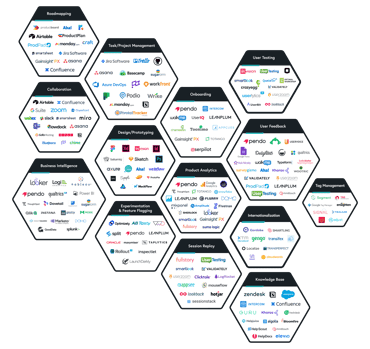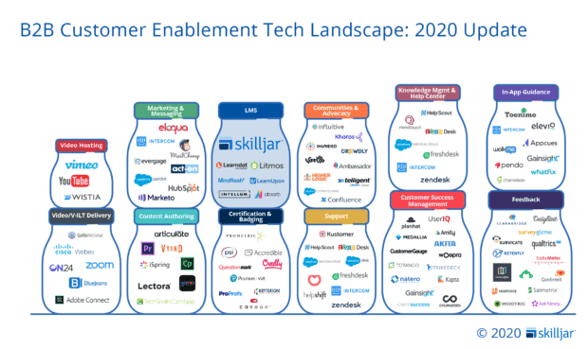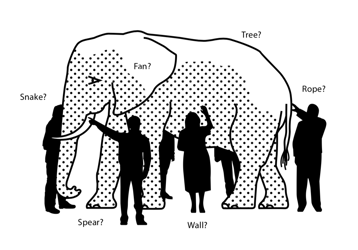4 Signs You Aren’t As Data Driven As You Think: Part 1- Data Siloes
In 2022, the world created around 2.5 quintillion bytes of data every day!
That’s 2,500,000,000,000,000,000. Every. Day.
That’s a lot of zeroes.
And it makes sense. We each use dozens of apps every day in our personal lives as well as in our professional ones. And the average number of SaaS apps in a midsize business is 187!
When an app is used it either generates or consumes data. Often both!
A tech stack for every function
Unfortunately, the number of apps used can get complex. And fast.
This is primarily because every function has its own “tech stack” these days.
For example, your sales and marketing tech stack might look like this:

Your product stack might look like this:

Your CS stack might look like this:

This is a lot to keep track of!
Yet, this isn’t even everything you see in a typical enterprise environment.
You likely also see workplace collaboration software, project management software, low/no-code tools. And so, so much more!
Sure, these vital systems keep the business humming. They also keep teams productive.
However, there is a downside to having all these systems. Siloed data. .gif?width=236&height=250&name=giphy%20(15).gif)
You have data that sits in different apps and places that are largely incompatible with each other.
This can lead to a host of challenges as described below, but the most important is that you are missing out on the insights that can only be uncovered when you stitch different parts of your business together.
So how do you know if you have data silos?
You can usually tell by the types of questions a team can answer. Or, at least answer easily.
Your salespeople can likely easily answer, “Which of my customers are renewing in March?”.
They usually do this by jumping into their CRM system.
But can they answer:
-
What are the top features used by the renewing customer?
-
What was the last request this customer sent to customer support?
-
How often does this customer receive messages from our company? And what do these messages look like?
These are such simple questions they shouldn’t require much digging, if any.

If your team needs to search in separate systems (or ask different teams) to answer these questions, it can quickly become counterproductive.
Yet, knowing the answers to these questions can dramatically improve the odds of renewal.
Being data-driven in a data silo is like driving in fog
There are a few reasons why data from different apps so often resides in different systems.
For one, each app is typically built to fulfill one function. So they weren’t built necessarily to “play well” in an enterprise setting.
Another common reason is because these apps are often SaaS apps. So, the data is stored in the cloud somewhere, hosted by the company that provides the app.

Regardless of the reason why the data is in silos, these data silos cause a distorted sense of reality. They make it difficult to accurately gauge business health.
This is because each individual—or function—can only see as far as the data available to them.
We end up with people willing to “go to the mat” on what data is most important and how best to interpret it.
It’s the classic “Blind Men and the Elephant” situation.

Even though everyone is touching the same thing, they all describe a different experience.
And this is despite everyone in the company having common goals and KPIs.
This misunderstanding often leads to poorly planned solutions that seem perfect for the immediate problem.
However, they usually aren’t sustainable in the long term.
Data silos produce multiple versions of the truth
Our first telltale sign that you’re not as data-driven as you could be is that everyone has their own version of the truth.
Teams working on siloed data sets tend to change and manipulate the data to perfectly fit their needs.
On a micro-level this helps boost productivity and reduce redundant work.

Yet, on an organizational level, this produces issues. Some of these issues can impact customer satisfaction.
For example, when the product team launches a new feature, the sales team may simply update their tools to account for that new feature.
How does the customer support team deal with the new feature? Likely in their own way.
So, each team collects the data “they” need, and other teams aren’t aware of how it’s accounted for. Indeed, they may not be aware of its collection in the first place.
Eventually, when teams try to tie together these datasets, the real problems start.
Like when the CS team tries to work with an account who has a question about a particular feature.
Yet, the CS team can’t find information about the function because there is a name or description mismatch.
Or, when an inaccurate billing date exists in the CRM system.

The product team might pick it and show it in the billing section of the app. This might lead to customer confusion and prompt a call to support.
This type of inconsistent data can cause major issues. It can also lead to unhappy, churned customers.
Holistic business data is key to long-term revenue growth and retention
At Tingono, we make it easy to retain and grow your customers.
To provide this value, we first break down data silos.
Once your customer, sales, and product data are pulled together, the magic happens.

Then our AI-powered Net Revenue Retention (NRR) platform goes to work.
This is how your revenue team can work smarter, work faster, and grow recurring revenue.
It’s also much faster, saving teams valuable time, and allowing them to focus on other things that can’t (yet) be done by a machine.
Want to become more data-driven?
Join us!





